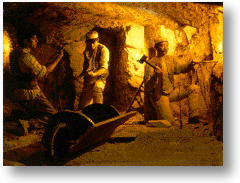| Small amounts of gold were found in Australia as early
as 1823 but the government of the time kept this information a secret.
There was concern that if the convicts heard about the finding of gold
they would rebel and also make every attempt to escape. The free settlers
would leave their jobs to search for gold. After 1840, when convicts were
no longer transported to New South Wales, news of gold discoveries did
not create too much concern and there was the added worry that many people
were now starting to leave the Australian colonies to find their fortune
in other parts of the world, particularly California.
In February, 1851, while panning for gold near Bathurst in New South
Wales, Edward Hargraves discovered small amounts of this precious metal
and this was recognised as the first official gold find in Australia. By
May of the same year, larger discoveries were made in the same area and
when the news was announced to the public, a gold rush started immediately.
Not long afterwards, Jemmy Irving, an aboriginal, found a nugget weighing
48 kilograms making his discovery between the Macquarie River and Meroo.
Other profitable sites were found and the cities started to empty as more
and more people went in search of their fortunes. Many of the early finds
were on the surface of the ground and it was not expensive for most seekers
to buy shovels, pans and other necessary equipment.
| Gold in Victoria:
Thousands of people began leaving the colony of Victoria heading for
the gold fields of New South Wales. Workmen walked away from their jobs
and there was no one to replace them. This was a terrible state of affairs
for newly established Melbourne and something had to be done to stop so
many workers from departing. A special committee was set up to solve the
problem and a reward of 200 pounds ($400) was offered to anyone who found
large quantities of gold within 320 kilometres of Melbourne. Some prospectors
made discoveries at Clunes and within a short time rich deposits of gold
were found in the Buninyong Ranges near Ballarat. Wealth seekers from
all parts of the country and from overseas started to arrive and more sites,
much better and larger than the ones in New South Wales, were found. |

|
|

|
